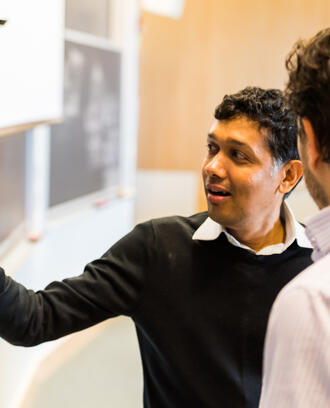MIT Executive MBA
Leadership
Why Organizations Need a Holistic Approach to Innovation
By
Oli Qirko EMBA '18
In the fast-paced world of technology, everything you do is at risk of becoming obsolete. This is particularly true in my area, the automotive electronics industry, which is going through tremendous disruption with electrification and self-driving cars. However, we aren’t the only ones in this situation. Many industries face the same challenges with change.At MIT, we learn about innovation in all types of organizations. I’ve found that there is not just one approach to innovation. Instead, the key to success is to take a holistic approach.
Assess strategy
A first step in this holistic approach is to determine which growth vertical will be a good fit for your organization. You will need to honestly assess fit between your growth mission and organizational capabilities, processes and culture. Pivoting to capture disruptive growth may require a simultaneous investment in organic development that is close to a core competence and a financial strategy that enables acquisitions to intercept growth opportunities or geographic expansion. A likely necessary culture shift can be eased by an alignment of processes, incentives and experimentation. The Organizational Processes, Competitive Strategy and Finance courses designed specifically for the EMBA program work in harmony, enabling leaders to apply different lenses, while assessing each situation.
Use quick iterative learning
Next, you need to revamp execution processes to fit innovation. Many hardware development companies utilize a linear “waterfall” development process for their new product designs. This strategy is ill suited for a dynamic environment where the product features may already be outdated by the time a development is complete. During our Innovation-Driven Entrepreneurial Advantage (IDEA) course, we utilized a short cycle to develop a “proof of concept” product to collect customer feedback and/or experiment. We then iterated using customer feedback or test results and tried it again. This fundamental loop of experimentation, learning and repeating is the motto of successful innovation during uncertainty and change.
Deal with uncertainty and be OK with “failure”
Throughout the process of experimentation, there will be many unknowns and “failures.” Shifting the decision-making process from the need to have all the data/answers/specs to driving key experimentation and smaller milestones, helps the organization develop a growth mindset, necessary in times of change. Moreover, System Dynamics analysis demonstrates that dividing the overall projects into smaller milestones can help reduce the “worse before better” phenomenon. Utilizing structured questioning methods during brainstorming helps leaders uncover key hidden information and effectively design experiments that lead to the ultimate solution more quickly. Finally, it is important to convert small failures to shared and applied knowledge. This shift in mindset from failure to learning is something many companies miss, but it is an important part of innovation.
Optimize work flow
Analyze work flow through a systemic lens. As part of my Organization Lab project, I applied the four basic principles below to an early-phase innovation at my company. As a result, we were able to reduce the time it took from idea to proof of concept prototype, from an average of six months to less than eight weeks. This acceleration enabled early and effective customer engagement, which is key to success in a competitive market like ours.
- Reconcile activity and intent – Each person doing the work needs to know why they are doing the work. This empowers individuals to make the right decisions at the right time, rather than waiting for a chain of command.
- Connect the human chain – Use simple and collaborative visual management tools to manage work flow and transitions from one person to another. This ensures you always know what is going on and can address delays and gaps to optimize results.
- Use structural problem solving – Synthesize problem statement, background, analysis, improvements, and recommendations in one single-page document (Toyota’s A3 or K-briefs). The goal is to use a common tool for problem solving and information transfer, so that anyone can easily pick up where you left off.
- Manage the optimal challenge – As previously discussed, instead of making a major change, take on smaller challenges that move you toward your goal. Utilize the innovation loop approach to learn and iterate while making small improvements.
Map out your own innovation work flow and ask if any processes violate these principles and if the metrics and incentives are aligned with the end goal.
Use the power of data for insights
Insights from data reduce the amount of uncertainty and supports our business intuition about where the market is going, what the next thing is going to be, and how we can do our jobs better. MIT’s focus on data analytics equips business leaders with useful tools needed to make robust and sustainable decisions. Many companies today either underutilize their data or have no useable data to extract insights. Yet, it is critical to set up a holistic data strategy that is in harmony with all other functions in your organization, from marketing to manufacturing.
Focus on the full customer journey
When developing a new product, deep customer knowledge and engagement is critical. Many corporations understand this need, hence a lot of effort is placed upfront to engage with customers. However, facilitating the full customer journey means not only developing desirable products and pricing to capture value, but also moving customers from problem recognition to purchase. This journey is even more complex in the business to business environment where each of the phases are handled by entirely different organization structures. Shifting your thinking from innovation as product features to end-user experience, turns cool technology into value creation and a sustained business profit for your organization.
In summary, innovation isn’t easy, but if you look at it holistically, you will have a better chance of success.
What is your approach to innovation at your organization?
Oli Qirko, EMBA '18, is the Senior Vice President, US Industrial Consumer and Energy Division at Cambridge Consultants.



